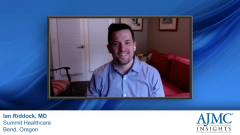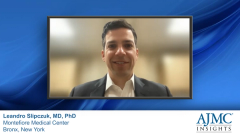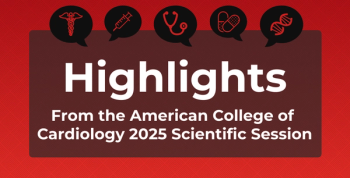
Who is an Ideal Patient for Early Intensive Lipid Lowering?
Ian Riddock, MD, describes the high-risk patient with ASCVD that is appropriate for early intensive lipid lowering.
Episodes in this series

Ian Riddock, MD: With regards to who to target with early intensive lipid-lowering therapy, I go back to one of the tenants of prevention, which is you must start with risk.
You’re not putting this stuff in the water. There are some who advocate that statins, for instance, are so safe that we should be putting it in the water. And then conversely, when there are high-risk patients, there are others that feel that or hesitant to treat those individuals intensely. When somebody comes in with an acute coronary syndrome or ASCVD [atherosclerotic cardiovascular disease] event, that is a very high-risk individual. And in my opinion, they’re lucky that they’re still around if they didn’t die suddenly. Unfortunately, far too many people when they have their first MI [myocardial infarction] just never even make it into the hospital because they drop dead. Now, whether it’s an NSTEMI [non-ST elevation myocardial infarction] or STEMI [ST elevation myocardial infarction] true plaque rupture vs a high-risk stenosis leading to unstable angina that maybe the plaque didn’t rupture well to get to that degree of a plaque that is obstructing blood flow, that plaque has ruptured and healed and ruptured and healed multiple times over potentially not causing any myonecrosis, but maybe all the stars didn’t align and it didn’t cause that occlusive thrombus. But make no mistake about it, those are— that’s high-risk plaque. Those are high-risk individuals. And this is where I come back to the various guidelines and different stakeholders that have issued guidelines and why a clinician needs to weigh all of these things. In my opinion I – because I’ve identified that patient as a high-risk individual, I’m not going to wait for them to have a second event before I say, “Yes, let’s put you on the most intensity therapy. Let’s now invoke those European Society of Cardiology Guidelines and you’ve had 2 events in a couple years, and we’re going to drive your LDL [low-density lipoprotein] cholesterol down to less than 40.” What needs to happen is a patient-centered discussion with your individual patient where you explain all of the nuances of these various recommendations and guidelines and you help them make a decision with you. And in my opinion in secondary prevention, I want to halt the progression of disease. And if I can reverse or regress it, all the better if I can do it safely. And far too often, I feel like in these individuals, we can only undertreat them. We have very safe and effective therapies and keep in mind that these are high-risk individuals. You don’t want to give a lower risk individual a ton of therapies that may cause some issues for them. And certainly, we have to be mindful of expense, but these high-risk individuals, you need to start it early because as we mentioned, that plaque is hot. Why is it hot? It’s inflamed because of various risk factors. But the single most important is the continuous bombardment of the endothelial wall with lipoprotein particles. And therefore, the best way that you can ensure that you are reducing inflammation and putting out that fire is by reducing the ongoing bombardment with lipoprotein or LDL-containing particles. And we have very effective therapy, it is no surprise to me when you see that when we intensify LD- lowering therapy, that we see those Kaplan-Meier curve separate rather quickly. And that just shows proof to that concept of reducing the serum concentration of those particles. Getting it on early and preferably before they leave the hospital, we’ve found that that improves adherence to therapy, and it reduces the likelihood that when they see somebody in follow-up that they may not be placed on the therapy if it were not initiated in the hospital. Once it gets initiated in the hospital, the follow-up provider is more likely to continue it and the patient’s more likely to stay on it.
This transcript has been edited for clarity.
Newsletter
Stay ahead of policy, cost, and value—subscribe to AJMC for expert insights at the intersection of clinical care and health economics.












































